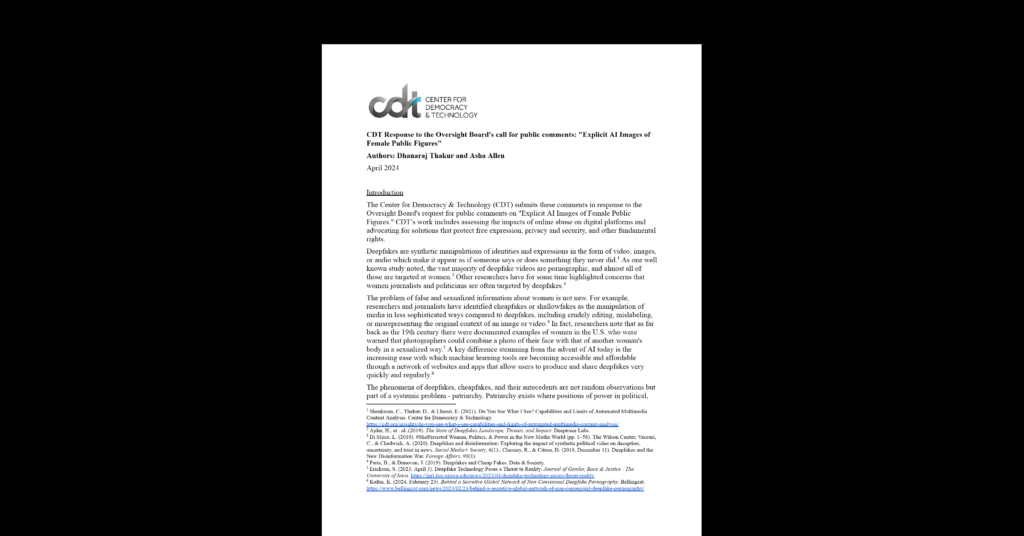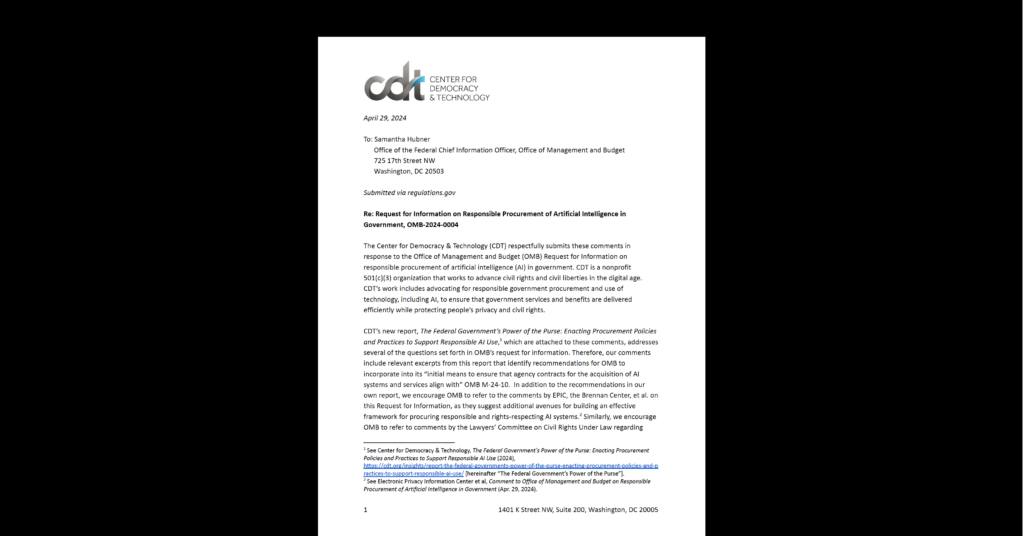AI Policy & Governance, Elections & Democracy, Privacy & Data
CDT CEO Alexandra Givens’ Remarks Before National AI Advisory Committee’s June 2023 Session
Thank you for including me today. I’m Alexandra Givens from the Center for Democracy & Technology, a nonpartisan, nonprofit organization working to protect civil rights and civil liberties in the digital age.
Policymakers across the world, in every branch of the U.S. federal government, and in state and local governments are grappling with how to navigate the risks and opportunities presented by AI. In this rigorous and somewhat cacophonous conversation, the NAIAC has an important role to play. As an advisory council of external experts surfacing issues to the federal government, the NAIAC can serve as a bridge for external stakeholders, helping people across different sectors of society share their concerns and have their interests represented. The series of meetings you’re convening this week are a good and welcome step. The walls of government can be hard to pierce for impacted communities in particular. It would be wonderful to see more of this type of engagement, including longer-form conversations, and assurances that NAIAC staff and members are reviewing the various agency RFI submissions and other public spaces where affected stakeholders are raising concerns about how AI harms may impact them, and looking to the federal government to lead.
As the NAIAC moves into its second year, I would like to surface 3 priorities.
The NAIAC’s first year report recognized the opportunity the federal government has to lead by example in the responsible development, deployment, use and funding of AI. The importance of this opportunity cannot be overstated, and the NAIAC should lean into its calls for government agencies to have adequate staff, resources, cross-government coordination, and guidance from the top. At a time when many private sector actors are grappling with how to responsibly approach their use and governance of AI, the federal government can demonstrate how to use robust, rights-affirming frameworks and methodologies for auditing, assessments, and decisions about whether to use AI systems at all. I hope NAIAC views its constructive Year One recommendations as a first step, and now plays an active role looking at how the federal government adopts and implements these ideas. This will be particularly important in the coming months when OMB issues its guidance to federal agencies on their use of AI; as well as to inform ongoing conversations about cross-agency coordination; how agencies report and detail their AI usage; procurement processes and more. In doing so, I hope NAIAC listens to and lifts up recommendations from outside stakeholders, especially those representing impacted communities and the American people.
Second, it’s not enough for the NAIAC to focus on the ‘how’ – these resource and process questions – but it must also be stronger on the ‘what’. As some other speakers have expressed, we were disappointed not to see the Administration’s AI Bill of Rights more expressly and directly endorsed in NAIAC’s First Year report, and hope to see it centered in the Committee’s recommendations going forward. The values enshrined in the Bill of Rights are closely aligned with the elements of trustworthy AI articulated in the NIST Ai Risk Management Framework and global frameworks too, and they ensure that AI governance is grounded in concrete expectations to protect people’s substantive rights. The NAIAC should formally endorse these substantive values, embrace them, and urge the White House to further adopt them as formal cross-Administration policy.
Third, on a specific note, the NAIAC will be called to respond to the explosion of generative AI. This area is complex, but one area that the federal government must navigate quickly is the way in which easily-affordable generative AI tools can dramatically increase the impact of fraud, exploitation, and mis- and disinformation, especially in sectors such as elections and public health. There are concrete efforts agencies can undertake, now, to defend against mis- and disinformation and boost their own credibility as trusted sources of information. The NAIAC can play an important role in this work as well.


